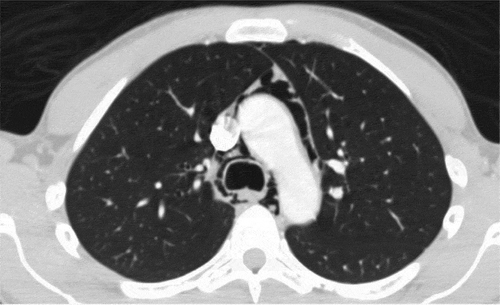ABSTRACT
Spontaneous pneumomediastinum (SPM), a rare occurrence, is defined by the presence of extraluminal gas in the mediastinum in the absence of trauma or underlying parenchymal disease. It is usually benign and has been associated with the inhalation of marijuana, cocaine, and amphetamines. The breathing maneuvers along with cyclical vomiting have been postulated as the underlying etiology. We present a case of a 27-year-old previously healthy male who presented with sudden onset chest pain and was found to have marijuana-induced pneumomediastinum.
1. Introduction
Pneumomediastinum is diagnosed by the radiographic presence of free air in the mediastinum. It can be primary (spontaneous) or secondary to trauma, lung disease, foreign body, or perforation. The incidence of spontaneous pneumothorax is reported between 0.001%- 0.014% of hospitalized patients. It is common in tall, young, thin adult males. SPM has been associated with inhalation drug use. We present a case of SPM secondary to marijuana use
2. Case presentation
A 27- year-old male presented to the emergency department for sudden-onset, sharp, pleuritic, chest pain radiating to the back. It was not associated with shortness of breath, fevers, or chills. He reported smoking marijuana daily. The day prior to admission he had several bouts of non-bilious vomiting and abdominal pain. On physical exam, he was not in acute distress. He had bilateral clear lungs, normal S1, S2, no murmurs, he had epigastric tenderness but no distension or rigidity. His laboratory workup was within normal limits. Computed tomography chest showed a pneumomediastinum, with air tracking from the region of the thoracic inlet surrounding the trachea and major vascular structures to the anterior cardiac region and a small amount of air tracking into the right supraclavicular region. He underwent esophageal fluoroscopy that revealed normal passage of contrast with no perforations. A few hours after admission his chest pain resolved and repeat imaging in 24 hrs showed significant improvement in his pneumomediastinum.
CT chest – demonstrating air within the mediastinum
3. Discussion
SPM has been associated with the use of inhalation drugs like cocaine, amphetamines and marijuana. In a retrospective study of 21 cases, 66.7% cases occurred in the setting of marijuana use and daily or more use was reported in 50% of the cases [Citation1]. The pathophysiology of SPM from smoking marijuana is likely due to barotrauma during breathing maneuvers.
There are two proposed mechanisms. Valsalva maneuver or forceful exhalation against a closed glottis creates a pressure gradient that increases the intrathoracic pressure resulted in alveolar over-distension and rupture into the lower pressure perivascular space. On the other hand, attempted inspiration through a closed glottis or Muller’s maneuver, results in a drop in intrathoracic pressure, which results in an increase in alveolar air volume, causing alveolar distension and rupture [Citation1]. Both mechanisms cause shear damage and air leakage along bronchovascular bundle into the mediastinum [Citation2]. In addition to barotrauma, inhalation injury can result in airway inflammation, edema, and increased alveolar permeability resulting in alveolar damage [Citation3]. Bronchoscopic studies from habitual smokers have demonstrated destruction of ciliated columnar epithelial cells with replacement by mucus secreting goblet cells, resulting in increased mucus production and impaired mucociliary clearance, hence predisposing individuals to bronchitis and pneumonia [Citation4] Cyclical vomiting is also a contributing factor as seen in our patient. Both the duration and frequency of smoking have not been quantified in the literature, and further studies are needed to establish a cumulative effect of smoking, if present. SPM secondary to drug use usually has a benign course and should be managed conservatively with supplemental oxygen and pain relief [Citation5]. Clinicians should be aware of this association and provide appropriate counseling.
Disclosure statement
No potential conflict of interest was reported by the author(s).
References
- Weiss ZF, Gore S, Foderaro A. Pneumomediastinum in marijuana users: a retrospective review of 14 cases. BMJ Open Respir Res. 2019 Feb 12;6(1):e000391. PMID: 30956805; PMCID: PMC6424304.
- Hazouard E, Koninck JC, Attucci S, et al. Pneumorachis and pneumomediastinum caused by repeated Müller’s maneuvers: complications of marijuana smoking. Ann Emerg Med. 2001 Dec;38(6):694–697. PMID: 11719752.
- Alqahtani A, Ammari Z, Ramahi A, et al. Cannabis smoking-induced diffuse alveolar hemorrhage. Cureus. 2019 Jul 6;11(7):e5089. PMID: 31511809; PMCID: PMC6726419.
- Tashkin DP. Marijuana and lung disease. Chest. 2018;154(3):653–663. ISSN 0012–3692.
- Bakhos CT, Pupovac SS, Ata A, et al. Spontaneous pneumomediastinum: an extensive workup is not required. J Am Coll Surg. 2014 Oct;219(4):713–717. Epub 2014 Jun 6. PMID: 25053221.

